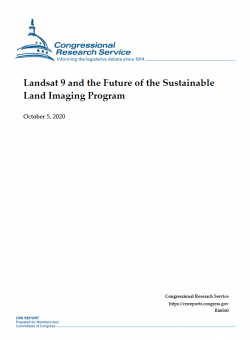November 25, 2020 • On October 5, 2020, the Congressional Research Service released a report titled: “Landsat 9 and the Future of the Sustainable Land Imaging Program.”
Excerpted from the report’s summary:
With the pending launch of Landsat 9, Congress may wish to consider the future of the Sustainable Land Imaging Program. A future moderate-resolution mission could differ from previous Landsat satellites by adopting a smaller satellite design, increasing image resolution, increasing the number of images captured per day, reducing the time between images of a given location, sensing a wider variety of optical and infrared frequencies, or making other design changes. Alternative arrangements could include obtaining images from other sources, such as through public-private partnerships or by procuring data from other satellites. Reports from stakeholders such as the Landsat Advisory Group and the National Academies of Sciences, Engineering, and Medicine have discussed such options and their tradeoffs. A joint NASA-USGS Sustainable Land Imaging Architecture Study has developed options for the follow-on to Landsat 9, known as Landsat Next, and the agencies anticipate sharing information about Landsat Next in the President’s FY2022 budget request. Whether Congress supports the agencies’ plans for Landsat Next or prefers some alternative, it may consider shaping the Sustainable Land Imaging Program and Landsat Next development through oversight activities, authorizing legislation (such as amendments to the Land Remote Sensing Policy Act of 1992), and appropriations bills and report language.
+ Download the full report

Be Part of What’s Next: Emerging Applications of Landsat at AGU24
Anyone making innovative use of Landsat data to meet societal needs today and during coming decades is encouraged to submit and abstract for the upcoming “Emerging Science Applications of Landsat” session at AGU24.





